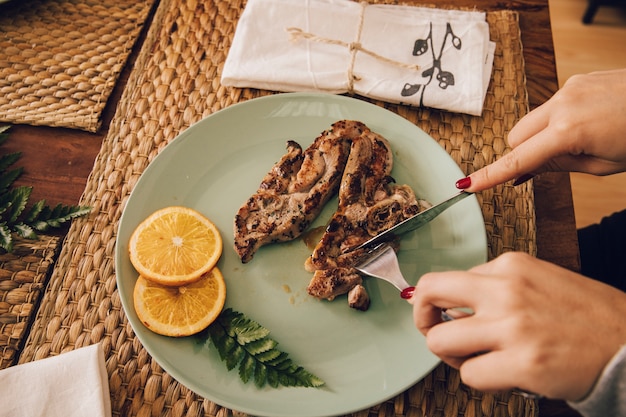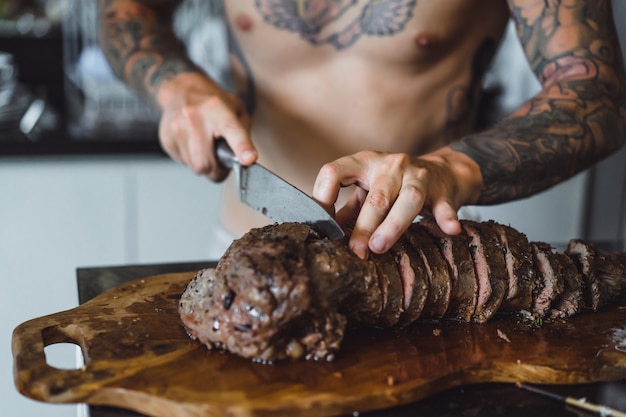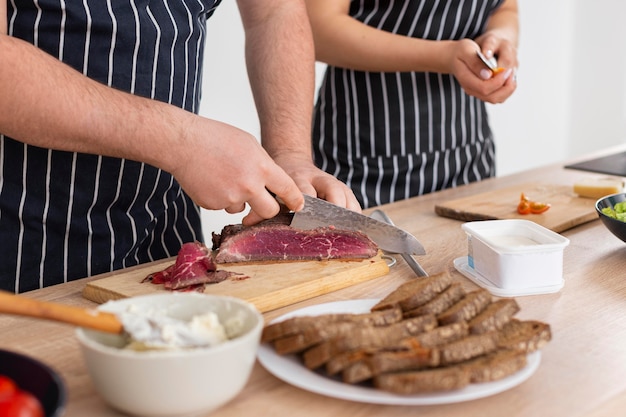Ah, brisket. The king of slow-cooked meats, a culinary triumph that takes time, patience, and a bit of know-how to master. It’s a cut that demands respect, a hefty chunk of beef from the animal’s breast or lower chest. It’s known for its toughness, but when cooked low and slow, it transforms into a tender, succulent masterpiece with layers of smoky flavor. Let me tell you, the payoff is worth every minute spent hovering over the smoker or peering into the oven.
But, how long does it take? That’s the million-dollar question. Well, the truth is, there’s no single answer. It depends on the size of your brisket, the cooking method you choose, and the temperature you're using. Let's dive in and break down the complexities of brisket cooking time.
(Part 1) Understanding brisket cooking times

What Factors Affect Brisket Cooking Time?
First things first, let’s unpack the key players in this brisket cooking drama.
- Brisket Size: Think of it like this, a smaller brisket is like a marathon runner who can finish the race quicker than a bigger one. The size of your brisket is the biggest factor influencing cooking time. A 3-pound brisket will need far less time than a hefty 10-pounder.
- Cooking Method: You’ve got two main choices here – smoking or roasting. Smoking is a slower, lower-temperature affair, a bit like a leisurely stroll through a park, while roasting is more akin to a brisk walk. Smoking takes longer to reach the desired tenderness.
- Cooking Temperature: The lower the temperature, the longer the journey to brisket nirvana. For both smoking and roasting, you'll want to stay within the 225-250°F range.
- Brisket Type: Brisket comes in two main forms: the point and the flat. The point is the thicker, fattier part, like the heart of the brisket, while the flat is the leaner, more muscular section. The point tends to need a bit more time to cook than the flat, needing that extra time to break down the fat and achieve melting tenderness.
Brisket Cooking Time Ranges: A Rough Guide
Okay, let’s get down to some rough time estimates. These are just starting points, so adjust based on the factors we just talked about:
| Brisket Size (lbs) | Smoking Time (hours) | roasting time (hours) |
|---|---|---|
| 3-4 lbs | 8-10 | 6-8 |
| 5-6 lbs | 10-12 | 8-10 |
| 7-8 lbs | 12-14 | 10-12 |
| 9-10 lbs | 14-16 | 12-14 |
Remember, this is just a starting point. You’ll need to use a meat thermometer and rely on your senses to know when your brisket is ready.
(Part 2) smoking brisket: A Journey in Smoke

Choosing a Smoker: The Right Tool for the Job
If you're going the smoking route, you'll need a good smoker. There are many types available, each with its own charm. Some popular choices include:
- offset smokers: These have a separate firebox and are known for their rich smoky flavor.
- Pellet Smokers: These are easy to use and maintain, fueled by wood pellets that create a consistent smoke.
- electric smokers: These are convenient and great for beginners, allowing you to control the temperature electronically.
Pick the smoker that best suits your needs and budget.
Preparing the Brisket for Smoking: Laying the Foundation
Now, let's get your brisket prepped and ready for its smoky transformation.
- Trim the Fat: Don't go overboard, but trim off any excess fat. Aim for a nice even layer of about ?? inch. This helps prevent overly fatty meat and allows for more even cooking.
- Season the Brisket: This is where the creativity comes in. Salt and pepper are the classics, but feel free to experiment with a brisket rub. I like to add some smoked paprika, garlic powder, and even a hint of brown sugar for a bit of sweetness.
- Place the Brisket on the Smoker: Make sure your smoker is preheated to the desired temperature (around 225-250°F) before placing your brisket.
- Smoke Low and Slow: This is the mantra of brisket smoking. Cook at a steady low temperature, allowing the time for the meat to break down and become tender.
- Add Wood Chips: This is where the magic happens. Add wood chips like hickory, pecan, or mesquite to your smoker to imbue your brisket with that smoky, wood-fired flavor.
- Wrap the Brisket (Optional): After a few hours of smoking, consider wrapping the brisket in butcher paper or foil. This helps trap in moisture and speed up the cooking process, especially in the final stages.
Checking for Doneness: Knowing When Your Brisket is Ready
Don't rely solely on time estimates. Check the brisket for doneness using a trusty meat thermometer:
- Use a Meat Thermometer: The brisket is considered done when the internal temperature reaches 195-205°F.
- The "Tenderness Test": You can also use a fork to test if the brisket is tender. If you can easily pull the meat apart with a fork, you're on the right track.
Resting the Brisket: Letting the Juices Reunite
After smoking, your brisket needs some TLC. Wrap it in foil and let it rest for at least 2 hours. This allows the juices to redistribute throughout the meat, leading to a more tender and flavorful brisket.
(Part 3) Roasting Brisket: A Kitchen Oven Adventure

Preparing the Brisket for Roasting: A Similar Path
Roasting brisket follows a similar path to smoking, just without the wood-fired smoke.
- Trim the Fat: As before, trim off any excess fat, leaving about ?? inch.
- Season the Brisket: Rub your brisket with your favorite spice mix. I find that a simple salt, pepper, and garlic powder works wonders.
- Place the Brisket in a roasting pan: Use a large roasting pan to accommodate your brisket.
- Roast Low and Slow: Preheat your oven to 225-250°F and let the brisket roast for a long time.
- Add Liquid: To keep the brisket moist, pour about a cup of beef broth or water into the bottom of the roasting pan. This will help create steam and keep the meat juicy.
Checking for Doneness: The Same Rules Apply
The same doneness indicators work for roasting as for smoking:
- Use a Meat Thermometer: Check for an internal temperature of 195-205°F.
- The "Tenderness Test": Use a fork to pull the brisket apart – it should be effortless.
Resting the Brisket: A Crucial Step for Juicy Perfection
After roasting, wrap your brisket in foil and let it rest for at least 2 hours. This will help the juices reabsorb into the meat, resulting in a more flavorful and tender brisket.
(Part 4) Troubleshooting Brisket Cooking: Conquering the Challenges
Brisket is Too Dry
This can be frustrating, but it’s fixable. It often happens if you haven't added enough liquid or haven't wrapped the brisket properly. To remedy this, you can add more broth or water to the pan during cooking, or wrap the brisket in foil for the last part of the cooking time.
Brisket is Too Fatty
If your brisket is too fatty, you can trim off excess fat before cooking. Also, be sure to remove any excess fat from the pan as it renders during cooking.
Brisket is Not Tender
This usually means that it hasn't cooked long enough. If your brisket isn't tender enough, you can cook it for a bit longer. You can also try wrapping it in foil for a while to help it cook more evenly.
(Part 5) Serving Brisket: The Moment of Truth
Your brisket is cooked to perfection – congratulations! Now, it's time to slice it up and enjoy the fruits of your labor.
- Slice Against the Grain: This is a crucial step in achieving tender brisket. Slice the brisket against the grain, into thin, even slices.
- Serve with Sides: Brisket is a versatile dish that pairs well with many sides. Think baked beans, coleslaw, potato salad, mac and cheese, or even cornbread. Let your imagination run wild.
- Enjoy! You've earned it!
(Part 6) Storing Brisket: Making the Most of Leftovers
If you're lucky enough to have leftovers (and I hope you are!), you can store your brisket in the refrigerator for up to 4 days. You can also freeze leftover brisket for up to 3 months. To freeze, wrap the brisket tightly in plastic wrap and then in foil.
(Part 7) brisket tips and Tricks: Lessons Learned
Here are some tips I've picked up over the years:
- Use a Meat Thermometer: This is your best friend. A meat thermometer will help you to accurately gauge the brisket's internal temperature and ensure it's cooked to perfection.
- Cook Low and Slow: It’s not a race. Low and slow cooking is essential for tender and juicy brisket. Be patient!
- Don't Overcook the Brisket: This will result in a dry and tough brisket.
- Rest the Brisket: Always let your brisket rest for at least 2 hours after cooking. This allows the juices to redistribute.
- Experiment with Different Seasonings: Don't be afraid to get creative with your rubs and spice mixes. There's no right or wrong answer here.
(Part 8) brisket recipes: Two Classic Recipes
Basic Brisket Recipe: A Simple Starting Point
This recipe is a great foundation for your brisket journey.
- Ingredients:
- 4-5 pound brisket
- 1 tablespoon salt
- 1 teaspoon black pepper
- 1 teaspoon garlic powder
- 1 teaspoon onion powder
- 1 teaspoon paprika
- Instructions:
- Preheat your smoker or oven to 225°F.
- Trim the excess fat from the brisket, leaving about ?? inch.
- In a small bowl, combine the salt, pepper, garlic powder, onion powder, and paprika.
- Rub the spice mixture all over the brisket.
- Place the brisket on the smoker or in the oven and cook for 8-10 hours (smoking) or 6-8 hours (roasting), or until the internal temperature reaches 195-205°F.
- Let the brisket rest for at least 2 hours before slicing and serving.
Texas-Style Brisket Recipe: A Smoky, Flavorful Classic
This recipe embodies the true spirit of Texas-style brisket cooking.
- Ingredients:
- 6-8 pound brisket
- 2 tablespoons salt
- 1 tablespoon black pepper
- 1 teaspoon garlic powder
- 1 teaspoon onion powder
- 1 teaspoon chili powder
- 1 teaspoon cumin
- 1 teaspoon smoked paprika
- Instructions:
- Preheat your smoker to 225°F.
- Trim the excess fat from the brisket, leaving about ?? inch.
- In a small bowl, combine the salt, pepper, garlic powder, onion powder, chili powder, cumin, and smoked paprika.
- Rub the spice mixture all over the brisket.
- Place the brisket on the smoker and cook for 10-12 hours, or until the internal temperature reaches 195-205°F.
- Wrap the brisket in butcher paper or foil after about 6 hours of cooking.
- Let the brisket rest for at least 2 hours before slicing and serving.
(Part 9) FAQs: Answering Your Brisket Questions
1. What Temperature Should I Smoke or Roast a Brisket?
The ideal temperature for smoking or roasting a brisket is between 225°F and 250°F. This low and slow cooking method is essential for breaking down the tough connective tissue and achieving a tender, juicy brisket.
2. How Long Should I Smoke or Roast a Brisket?
The cooking time depends on the size of your brisket and your chosen method. A 4-5 pound brisket typically takes around 8-10 hours to smoke and 6-8 hours to roast. Larger briskets will require more time. Remember, always use a meat thermometer and rely on the tenderness test to determine when your brisket is ready.
3. How Do I Know When a Brisket is Done?
You can tell if your brisket is done by checking the internal temperature with a meat thermometer. The brisket is considered done when it reaches an internal temperature of 195-205°F. You can also use the "tenderness test" to check if the brisket is done. If you can easily pull the brisket apart with a fork, it's ready.
4. What Happens If I Overcook My Brisket?
Overcooked brisket can become dry and tough. To avoid this, stick to a low and slow cooking method, and check the internal temperature regularly. Wrapping the brisket in foil for the last part of the cooking time can help retain moisture and prevent overcooking.
5. What Are Some Good Sides to Serve with Brisket?
Brisket is a versatile dish that pairs well with a variety of sides. Some classic options include baked beans, coleslaw, potato salad, mac and cheese, cornbread, and even a simple green salad.
Now, you have all the knowledge you need to embark on your own brisket journey. Remember, it’s a process, a dance between heat, time, and patience. But trust me, the reward is worth it. The aroma of smoked brisket, the joy of pulling it apart with a fork, and the satisfaction of creating a culinary masterpiece – it’s all part of the brisket experience. Happy cooking!
Everyone is watching

How to Cook Frozen Lobster Tails Perfectly: A Step-by-Step Guide
RecipesLobster. Just the word conjures up images of lavish meals, special occasions, and a taste of luxury. But let's...

Pigs in a Blanket Cooking Time: How Long to Bake for Perfect Results
RecipesAh, pigs in a blanket. Just the name conjures up images of those delightful little parcels of crispy pastry en...

Pork Fillet Cooking Time: How Long to Cook It Perfectly
RecipesPork fillet, or tenderloin as it's sometimes called, is a real favourite in our house. It's so versatile, and...

The Ultimate Guide to Tender, Juicy Pulled Pork
RecipesRight, let's talk pulled pork. It's one of those dishes that just screams "comfort food," doesn't it? I mean...

The Ultimate Guide to Cooking Sweet Potatoes: From Roasting to Mashing
RecipesSweet potatoes. Just the name conjures up images of warm, comforting dishes, bursts of vibrant color, and a to...
